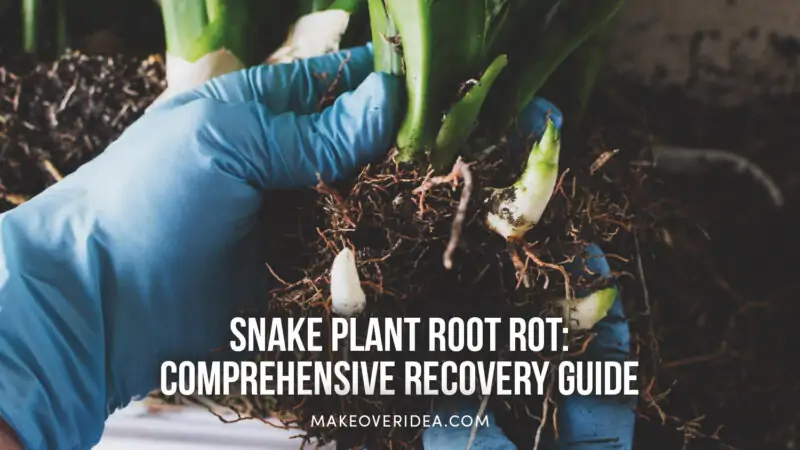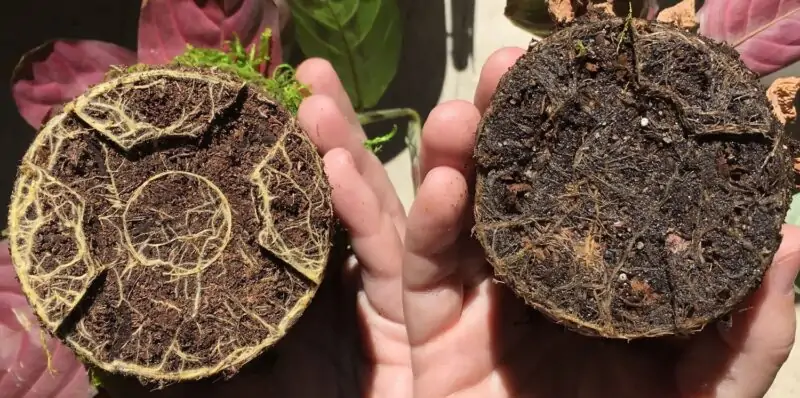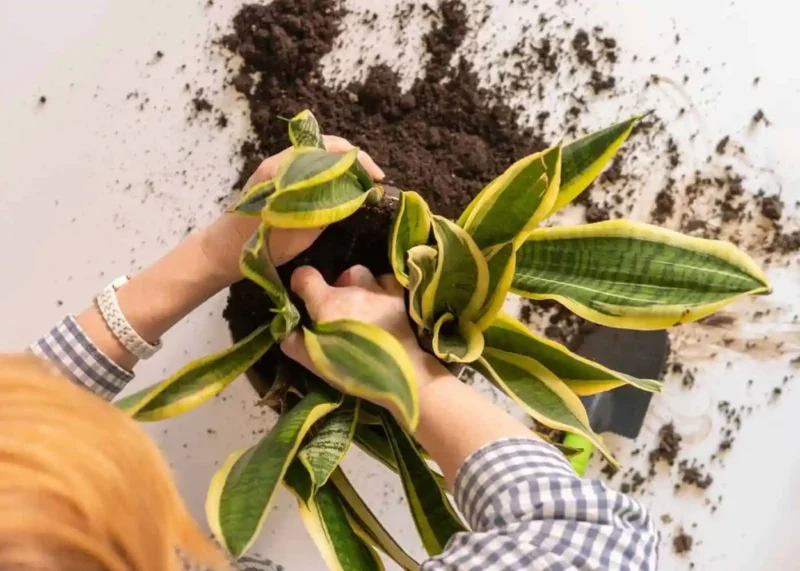How to Fix Snake Plant Root Rot: Comprehensive Guide

Snake plant root rot is a serious problem that most typically occurs if you overwater your snake plant. In this article, we’ll go over everything you need to know to keep your snake plant healthy: from identifying root rot symptoms to treating root rot in the most effective way possible to save your beloved greenery.
Identifying Snake Plant Root Rot
Snake plant root rot occurs when the roots become damaged or infected by fungi or bacteria. Usually, root rot is caused by overwatering your snake plant with poor soil drainage being the second most often root rot cause. While it may sound scary (and, surely, root rot can kill your plant very fast), there are some signs and symptoms of this condition that will help identify whether your snake plant has been affected.

What are the signs of snake plant root rot?
The first sign that there are problems with snake plants is often yellow leaves, which indicate an excessive amount of water being retained in the soil. This means that your beloved snake plant has difficulty absorbing nutrients through its roots because they is too much water beneath the soil and your plant is virtually drowning. Other symptoms include:
- Brown, mushy roots
- Foul odor from potting soil (soil contaminated by pathogens)
- Wilting leaves
- Soft stems and leaf bases
So, if you see your snake plant wilting, and the symptoms described above, you need to make sure that your snake plant is not suffering from rotted roots.
What causes root rot in snake plants?
Watering your plant too frequently is one major cause of any kind of houseplant death, including indoor succulents. Root rot caused by overwatering is so common an issue that it is really impossible to understate the importance of the proper watering routine.
Giving too much water or overwatering your plant creates anaerobic conditions within the pot, which means no oxygen supply for the rhizosphere (the area surrounding roots). It leads not only to damage but also makes it easier for fungi and bacteria present naturally on surfaces around us to infect the plant.
Another common cause of root rot might be using old dirt or potting mixtures without knowing their nutrient value or quality. For this reason, it is always advisable to use fresh cactus soil mixtures.
Saving Snake Plant from Root Rot

If the leaves of your plant have yellow edges like in the picture, this means that your snake plant sends you a cry for help. Don’t panic! There are some steps you can take at home to try and save your plant before it’s too late.
How to treat snake plant root rot at home
The first step in treating a snake plant with root rot is removing the affected area of the roots. This may seem scary, but trust us – this will give your plant a fighting chance!
Remove the plant from its pot and check your plant roots for symptoms of rotting. Gently brush off dirt around the roots at the base of your plant and do your best not to damage leaves or stem. If the roots appear mushy, brown, or soft, then cut these portions of the plant cleanly so unaffected areas can survive. This is the most reliable way to give your plant a chance to survive: a time-proven way of treating root rot is to remove affected areas altogether.
Once you have done that, wash the remaining healthy roots at the base of the plant under running water for a few minutes. After washing, let the excess water drain away completely (for about 30 minutes). Repot the plant into a new soil mixture prepared beforehand as per recommendations given on the packet.
Overwatering your replanted snake plant may result in its dying: do not use too much water until signs of recovery start appearing, which might happen gradually. Patience is required throughout the process: still, saving your old green friend is better than buying a new plant.
Can a snake plant recover from root rot?
Yes! If caught early enough and treated appropriately, many plants can make full recoveries after suffering from root rot. Your snake plant needs quick action and continual monitoring of its progress after treatment so that any issues can be addressed promptly.
Overwatered snake plant root rot: How to fix?
Overwatering should never occur since healthy snake plants and other succulents do not require much moisture compared to other species. However, sometimes people forget how often they’ve been watering recently, leading to unintentional consequences such as fungal infections caused by pathogens present naturally around us, including our own bodies. To fix an over-watered situation:
- Take care when next watering the plant to ensure that it is not over-watered again. Repot into a fresh soil mixture as per instructions given on the packaging and make sure drainage holes are present in the pot.
- Leave your snake plant alone for a few days and monitor its progress closely. If you notice any signs of continued decline, consider seeking professional assistance from gardeners or horticulturists.
Repotting Your Snake Plant with Root Rot
If your snake plant has severe root rot, then repotting may be necessary to save it. Here’s how to do so safely and effectively:
How to repot a snake plant with root rot
- Carefully take out the entire pot without damaging leaves or stem.
- Gently brush off dirt around roots while examining them thoroughly for mushy, brown, or soft roots. Cut these parts cleanly using shears or scissors if detected so unaffected areas can survive.
- Wash the remaining healthy roots under running water for a few minutes after brushing away old soil completely, followed by letting excess water drain away (for about 30 minutes).
- Prepare a new pot filled with fresh, well-drained soil mixtures made specifically for houseplants like this one. Place some gravel at the bottom before putting in the newly cleaned rhizosphere, gently pressing the topsoil firm enough to accommodate the stem securely but avoid compacting it too much.
- Wait until symptoms start disappearing gradually, which might occur quite slowly depending upon the ecosystem created within the new environment, provided the above-mentioned steps are taken properly. Otherwise, consult professionals immediately (if needed).
- Continue monitoring throughout the process, ensuring proper care and watering schedules are followed religiously. Alongside other recommendations received during the diagnosing phase leading up to the repotted situation, this can prevent future problems like this from happening again!
Preparing Fresh Soil For Your Snake Plant
When preparing the fresh soil mixture required for replantation following cutting out affected areas of roots due to rotting, it is important to choose a high-quality mix that contains the right balance of nutrients and minerals. A mixture with perlite, vermiculite, or coconut coir makes for an ideal soil blend since they offer excellent drainage properties.
Preventing Future Root Rot in Snake Plants
The best way to prevent root rot from occurring in your snake plant is by taking proper care of it on a regular basis. Here are some tips:
- Water your snake plant only when the top inch of soil feels dry.
- Avoid overwatering by ensuring that there’s adequate drainage in the pot.
- Use well-draining, nutrient-rich soil and fertilize as needed.
- Avoid keeping them near drafty windows or air conditioners/heaters, which can cause temperature fluctuations leading to unexpected results (rot, dryness, etc.)
Caring for Your Snake Plant after Root Rot Recovery
Once you’ve successfully treated your snake plant’s root rot, it’s important not to let your guard down entirely! Keep monitoring their progress closely so any issues can be addressed promptly before things get out of hand again.
Watering And Plant Care Tips For Snake Plants
To ensure optimal health following the recovery period:
- Provide ample sunlight but avoid direct sun, especially during the hottest hours of the day (noon).
- Maintain a consistent watering schedule without overdoing it, avoiding waterlogging situations once more.
- Fertilize with organic matter like composted manure, worm castings, etc., applying according to manufacturer instructions given on the packaging.
- Regularly prune damaged leaves and stems using clean shears or scissors and disinfectants available at local stores or gardening sections of shops.
Monitoring Your Snake Plant For Signs Of Rot
Be vigilant about looking out for warning signs that could lead to future problems, such as fungal infections caused by pathogens present naturally all around us, including our own bodies. Keep an eye on the roots, leaves, and stems regularly to ensure they remain healthy and thriving.
FAQs
The signs of root rot in a snake plant include yellowing leaves, brown mushy roots with a foul odor from the potting soil, and wilting or soft stems.
Yes! If caught early enough and treated appropriately as per the instructions given above, many plants can make full recoveries after suffering from it.
You need to remove affected areas, cut cleanly, wash away remaining parts that aren’t damaged, and replant in a new fresh soil mixture made specifically for houseplants like this one. Avoid overwatering again until symptoms show improvements, which might occur gradually. Continue monitoring progress throughout the process, ensuring proper care and watering schedules are followed religiously alongside other recommendations received during the diagnosing phase leading up to the repotted situation. This can prevent future problems like this from happening again!
It requires cutting out affected areas carefully while repotting into fresh, well-drained, nutrient-rich soils, following all guidelines mentioned earlier.
Conclusion
In conclusion, there are several steps that you can take at home to identify, treat, and even prevent snake plant root rot for your beloved green friend. By being vigilant about its health through regular check-ins and implementing precautions against potential risks associated with such issues arising unexpectedly, you will help guarantee long-term survival for these beautiful indoor succulents. Remember- prevention is always better than cure, so be consistent when providing optimal living conditions, including routine maintenance checks, keeping them as happy and healthy as possible!